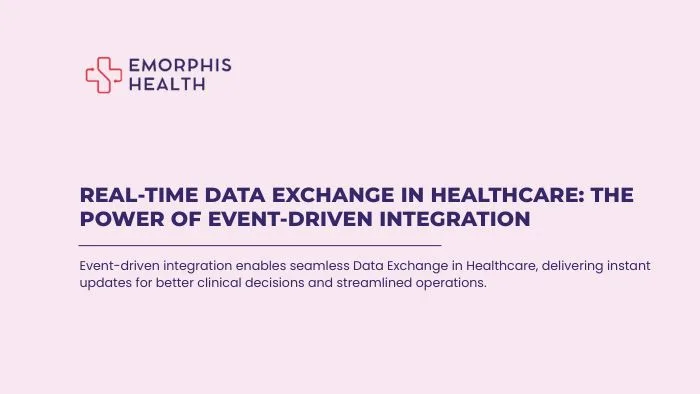Modern healthcare ecosystems depend on seamless data flow between EHRs, laboratory systems, imaging centers, mobile health apps, AI analytics tools, and payer networks. But these systems often speak different languages, leading to interoperability issues, data silos, and inconsistent patient records.
A scalable Integration Architecture solves this problem by defining a structured framework for how healthcare systems communicate, share, and process data securely and efficiently. It provides a blueprint for integrating both legacy and next-gen healthcare applications across cloud and on-prem environments.
This article walks you through how to design a scalable healthcare integration architecture with a focus on layered components, API Gateway, Message Broker, FHIR Server, and Data Lake, along with best practices for implementation.
Understanding the Need for Healthcare Integration Architecture
See Contents
- 1 Understanding the Need for Healthcare Integration Architecture
- 2 Layered Architecture for Healthcare Integration
- 3 1. API Gateway Layer – The Unified Control and Access Point
- 4 2. Message Broker Layer – The Integration Engine of Healthcare Systems
- 5 3. FHIR Server Layer – The Interoperability Foundation
- 6 4. Data Lake Layer – The Foundation for Advanced Analytics
- 7 Best Practices for Building a Scalable Healthcare Integration Architecture
- 8 Bringing It All Together
- 9 Conclusion
Healthcare organizations manage enormous data volumes — from patient demographics and clinical reports to imaging, billing, and remote monitoring streams. Without a well-planned Integration Architecture, these datasets remain fragmented.
A strong integration framework ensures that:
- Data flows securely between clinical and operational systems.
- Interoperability standards like HL7, FHIR, and DICOM are enforced.
- Data analytics platforms can access reliable, standardized information.
- Healthcare applications remain scalable as new digital tools are introduced.
The rise of digital health, connected devices, and AI-based clinical support systems makes an adaptable Integration Architecture non-negotiable. It underpins real-time decision-making, reduces administrative overhead, and enhances the overall care experience.
Layered Architecture for Healthcare Integration
A scalable healthcare Integration Architecture typically includes the following layers:
- API Gateway Layer
- Message Broker Layer (Kafka / Mirth / MuleSoft)
- FHIR Server Layer
- Data Lake Layer
Let’s break down how each of these layers contributes to an efficient Integration Architecture.
1. API Gateway Layer – The Unified Control and Access Point
The API Gateway acts as the entry point to your healthcare ecosystem. All external applications, devices, and partner systems interact with backend services through this layer.
It simplifies integrations by exposing standardized APIs while managing traffic, security, and versioning centrally.
Core Responsibilities:
- Authentication & Authorization: Ensures only authorized entities access protected healthcare APIs.
- Traffic Routing & Load Balancing: Distributes requests intelligently across services to prevent overload.
- Request Transformation: Converts incoming data into required internal formats.
- Throttling & Rate Limiting: Protects backend systems from spikes or misuse.
- API Analytics & Logging: Provides real-time visibility into usage patterns and performance.
Popular Technologies:
- AWS API Gateway for cloud-native integration.
- Apigee (Google Cloud) for full-scale API lifecycle management.
- Kong or NGINX for self-hosted, high-performance gateway control.
- Azure API Management for hybrid and enterprise-grade integrations.
Best Practices:
- Implement OAuth 2.0 or OpenID Connect to manage user identity securely.
- Use JWT tokens for session management.
- Version APIs to support backward compatibility.
- Establish a consistent naming convention and documentation through Swagger or Postman collections.
A scalable Integration Architecture begins with an API Gateway that enforces security, consistency, and reliability while enabling healthcare organizations to expose APIs to partners, mobile apps, and digital health startups with confidence.
2. Message Broker Layer – The Integration Engine of Healthcare Systems
The Message Broker is the heart of the Integration Architecture. It ensures asynchronous, reliable communication between diverse healthcare applications and systems, decoupling senders and receivers so that one system’s failure doesn’t affect others.
In healthcare environments, where data arrives in multiple formats and speeds (EHR updates, device feeds, lab results), this layer enables smooth message flow and transformation.
Key Capabilities:
- Message Routing: Directs messages to appropriate destinations based on defined rules.
- Protocol Translation: Converts between HL7 v2, FHIR, DICOM, and RESTful formats.
- Queue Management: Ensures message delivery even if the recipient is temporarily offline.
- Data Transformation: Normalizes data structures between legacy and modern systems.
Popular Tools:
- Apache Kafka: Ideal for high-volume real-time event streaming from IoT and patient monitoring devices.
- Mirth Connect: A healthcare-specific integration engine that supports HL7, FHIR, CCD, and DICOM standards.
- MuleSoft: Enterprise-grade integration platform offering advanced orchestration, transformation, and analytics.
Best Practices:
- Use event-driven architecture (EDA) to process healthcare events in near-real time.
- Implement dead-letter queues and retry mechanisms to manage delivery failures.
- Apply data encryption and digital signatures for secure message transmission.
- Monitor message throughput and lag using tools like Confluent Control Center or MuleSoft Anypoint Monitoring.
The Message Broker layer makes the Integration Architecture resilient, ensuring seamless communication between clinical, administrative, and analytical systems — even under high load.
3. FHIR Server Layer – The Interoperability Foundation
The FHIR Server (Fast Healthcare Interoperability Resources) is where standardized data exchange comes alive. It provides structured access to healthcare data using a globally recognized format.
In an Integration Architecture, the FHIR layer acts as the unifying data interface between EHRs, mobile apps, research systems, and third-party applications.
Core Components:
- FHIR Repository: Stores clinical data (patient demographics, observations, encounters) in a standardized structure (JSON/XML).
- FHIR APIs: Enable CRUD (Create, Read, Update, Delete) operations on healthcare resources.
- Terminology Services: Manage vocabularies like SNOMED CT, LOINC, ICD-10 for semantic consistency.
- Consent & Access Control: Enforce patient privacy, data masking, and role-based access.
Implementation Options:
- HAPI FHIR (Open Source) for flexibility and custom implementations.
- Firely Server for production-grade deployments.
- Azure Health Data Services FHIR API or Google Cloud Healthcare FHIR API for scalable cloud-native interoperability.
Best Practices:
- Maintain FHIR resource versioning to manage changes safely.
- Use SMART on FHIR for secure app authorization and EHR integration.
- Map legacy data from HL7 v2 or CDA formats into FHIR using transformation pipelines.
- Validate FHIR profiles using tools like Inferno or Touchstone for compliance.
The FHIR Server turns your Integration Architecture into a future-proof ecosystem aligned with global interoperability standards, enabling real-time data sharing across healthcare organizations and partners.
4. Data Lake Layer – The Foundation for Advanced Analytics
The Data Lake layer serves as the analytical core of the Integration Architecture. While other layers focus on data movement and exchange, this layer captures, stores, and organizes both structured and unstructured data for analytics, AI, and compliance purposes.
Purpose and Role:
- Acts as a single source of truth for all healthcare data.
- Enables predictive analytics, population health management, and operational intelligence.
- Supports long-term data archiving with cost-efficient storage.
- Integrates seamlessly with business intelligence and ML frameworks.
Common Technologies:
- AWS S3 / Redshift for cloud-based storage and analytics.
- Azure Data Lake for scalable, enterprise healthcare data storage.
- Google BigQuery or Snowflake for large-scale query and analysis.
Best Practices:
- Maintain metadata catalogs for data discovery (using AWS Glue or Azure Purview).
- Apply data partitioning by department or patient ID for optimized querying.
- Ensure compliance with HIPAA, GDPR, and HITECH using encryption and access policies.
- Integrate ETL/ELT tools (like Apache NiFi or Talend) for efficient ingestion and transformation.
By connecting your Data Lake to the FHIR layer and message broker, the Integration Architecture delivers a seamless flow of data from clinical transactions to insights — powering predictive diagnostics, resource optimization, and value-based care analytics.


Best Practices for Building a Scalable Healthcare Integration Architecture
Designing a future-ready Integration Architecture requires not just the right tools, but also disciplined design principles.
1. Embrace Modularity and Microservices
Decompose the architecture into independent services — making it easier to scale specific components without affecting others.
2. Prioritize Data Security and Compliance
Encrypt data in transit and at rest, use secure authentication, and maintain audit logs to align with HIPAA, GDPR, and ISO 27001 requirements.
3. Leverage Cloud-Native Services
Deploy integration components across AWS, Azure, or GCP to scale elastically and integrate with managed services.
4. Implement Centralized Monitoring and Observability
Use tools like Grafana, Prometheus, or ELK Stack to monitor system performance, latency, and event flow in real time.
5. Design for Fault Tolerance
Set up replication, message persistence, and failover mechanisms to ensure continuity during outages.
6. Focus on Data Governance
Implement data lineage tracking, access control, and retention policies to maintain integrity and traceability.
A well-designed Integration Architecture not only connects systems but also prepares your healthcare organization for continuous evolution, supporting new applications, AI models, and compliance frameworks effortlessly.
Bringing It All Together
A layered Integration Architecture unifies healthcare systems, streamlines workflows, and ensures that patient data remains consistent, accessible, and secure across the care continuum. By combining the strengths of an API Gateway, Message Broker, FHIR Server, and Data Lake, organizations can enable real-time interoperability while maintaining scalability and compliance.
Whether integrating a new telehealth platform, connecting IoT medical devices, or enabling cross-organization analytics, this architecture provides a resilient foundation for innovation in digital health.
Investing in robust Integration Architecture services today is not just a technical decision — it’s a strategic one. It empowers healthcare organizations to scale faster, collaborate smarter, and deliver better patient outcomes through connected intelligence.
Integration Architecture – The Key to Connected Healthcare
As healthcare systems evolve toward digital-first, data-driven care, the Integration Architecture becomes the core foundation that keeps everything running seamlessly.
Investing in the right architectural framework, supported by reliable tools like Kafka, Mirth, MuleSoft, and FHIR, not only ensures interoperability but also unlocks opportunities for innovation, real-time insights, and better patient outcomes.
Conclusion
Designing a scalable healthcare Integration Architecture is not just about connecting systems; it’s about building a digital foundation that ensures data flows intelligently, securely, and reliably across the healthcare continuum. When designed thoughtfully, such an architecture becomes the nervous system of a healthcare organization, enabling seamless interoperability, efficient workflows, and real-time insights that ultimately improve patient care.
By layering components like the API Gateway for controlled access, the Message Broker for real-time data flow, the FHIR Server for standardized interoperability, and the Data Lake for analytics and intelligence, healthcare organizations can transform fragmented systems into a connected ecosystem. This layered approach makes the Integration Architecture resilient, scalable, and adaptable to future technologies — from AI and IoT to predictive analytics and cloud-based applications.
As healthcare continues to evolve toward precision medicine, digital therapeutics, and patient-centered care, a robust Integration Architecture will remain the cornerstone of innovation. It not only simplifies compliance with interoperability standards but also empowers healthcare providers, developers, and data scientists to build smarter, faster, and more connected healthcare systems.
In essence, a well-engineered Integration Architecture isn’t just a technical framework; it’s a strategic enabler of digital transformation in healthcare.






